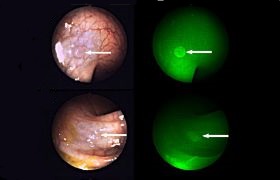Fluorescence improves search for colorectal polyps
Because colorectal polyps can transform into cancer, they are generally removed upon identification during colonoscopy. However, small and flat polyps are often missed during this procedure. Scientists at the Leiden University Medical Centre (LUMC) have therefore developed a molecular technique which visualises these polyps by making them fluorescent, they write in Nature Medicine.
The new solution contains the substance GE-137, which binds the c-Met receptor, as well as harbouring a fluorescent dye. c-Met is highly expressed in colorectal polyps and tumours. The author professor James Hardwick, working at the department of gastroenterology and hepatology in the LUMC, explains: “GE-137 is administered intravenously, upon which the substance specifically accumulates in polyps. Hence, we can see fluorescence at the location of colorectal polyps during colonoscopy – even in the case of small, flat polyps.”
The researchers measured the efficacy of GE-137 for the detection of colorectal polyps in a group of 15 patients with an increased risk for colorectal cancer. In total, they found 101 polyps, of which 47 were in an early cancer stage. Nine of these precancerous polyps were only seen with fluorescence. Furthermore, the study confirmed the safety of GE-137 in humans.
Before further investigations can commence, more of the fluorescence colonoscopes specially designed for this project will have to be manufactured. “The next step will be to set up a much larger study with patients selected from the bowel cancer screening programme”, Hardwick says. “We will investigate whether our technique also has additional value for this group of patients.”
Sources: LUMC, Nature Medicine
MedZine writes about notable science twice a week.







